|
The controversy over
the church pulpit
|
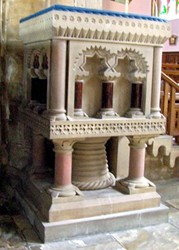
The Abbey Church |
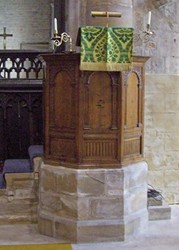
Frampton parish church |
There have been many alterations to
the Abbey Church during its 900 years of history but not all have met with
universal approval. Those responsible usually had the money to finance
major changes and therefore called the tune but the result was not always
accepted as being beneficial for this historic building.
One of the most controversial changes was to scrap the carved oak pulpit
during the 19th century, a decision which rankled with many churchgoers at
that time, and still has a resonance today although we have learned to
live with the stone replacement.
The pulpit is the elevated platform from where the Sunday sermon is
delivered to the congregation by the parson, introduced into our churches
during the 14th century and since they are the focus for teaching, images
of the four evangelists or the four Latin doctors are frequently found
carved around them. Those built before the Reformation are usually of wood
and recognisable by their perfect proportions but many were replaced
during Victorian times and are therefore out of character with a country
church. Stone pulpits however, date from 200 years earlier and are
therefore fewer in number.
The former pulpit in the Abbey Church was probably constructed at the
beginning of the 17th century and, as with others of this period,
generally termed Jacobean and was exceedingly simple and pleasing in
design and appearance. But it did not appeal to everyone and was
particularly disliked by the parish’s principal benefactor, Robert Mason
Mills, who was also a churchwarden.
Mills (1819-1904) was a wealthy man, a chemist who made his money from the
aerated water business he founded to take advantage of the prolific
artesian wells which were tapped around Bourne during the 19th century,
and he was also a dedicated supporter of the church, providing vast sums
of money for the upkeep and improvement of the building.
In 1883, the west
end was restored practically at his expense, in memory of his wife Fanny
who had died two years earlier on 10th September 1881 at the age of 58,
and his generosity is marked by a plaque saying: "To record the
restoration of the west end of this church by Robert Mason Mills of
Bourne, this brass plate is placed by the congregation: 1883."
Four years later, he paid for three new stained glass windows to be
installed in the south wall to commemorate Queen Victoria's Golden
Jubilee. The centre window bears in each corner the inscription Victoria
Jubilee with the date 1887 in the middle. He also completed the
restoration of the nave in 1893, the chancel in 1903 together with the
porch and south roof.
| This period of restoration also
included the removal of the twin aisles that had been a feature of
the church in centuries past together with the pen or box pews that
were much favoured in earlier times. The floor level was also
lowered and the church began to take on the appearance that we are
familiar with today. In 1890, the present stone pulpit was installed
to replace the old wooden Jacobean one which was sold off to the
parish church at Frampton, near Boston, for three guineas plus three
loads of stone left over from the alterations to the building for an
additional 15s. which were used to build the base at the new
location. |
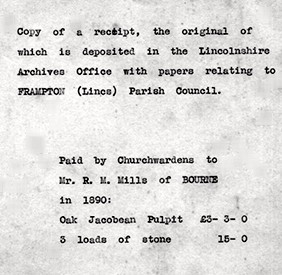 |
This has since been considered to be an error of judgment, perhaps
influenced by the erroneous belief of the time that Norman churches had
stone pulpits whereas they did not even exist in the 12th century and this
pseudo-Norman copy was condemned as an anachronism by Charles Pask
Matthews (1886-1956) in his history of the Abbey Church published soon
after he retired after 25 years as headmaster of Bourne Grammar School. He
was a regular worshipper and took a particular interest in the building
and his short history which appeared in 1951, became so popular that it
ran to five editions and remains the starting point today for historians
researching the 12th century church.
It would appear however that Mills’ decision to proceed may also have
caused dissent within his own family, notably with his son in law, Thomas
Moore Baxter (1854-1920). He was a chemist who was engaged by Mills in 1878 to run
his shop at No 1 West Street, subsequently marrying his employer’s only
daughter, Emily, later becoming his business partner and then taking over
the running of the company. He also became one of the town’s most
prominent citizens and like his father in law, he was a staunch churchman
and became vicar's warden at the Abbey Church in 1893, serving three
incumbents for the next 27 years and from 1892, also acting as treasurer
for the various restoration funds associated with the building.
He did not approve of the new pulpit but was unable to prevent the project
from going through yet even when it was installed, he still had hopes that
it might be removed and replaced with something like the original. When he
died, he left a bequest of £100 in his will to the Abbey Church with the
request that it be spent on a Jacobean oak pulpit, either an original or a
reproduction, to replace the one that had been lost but although the money
was received and the church architects, Traylen and Lenton of Stamford,
instructed to provide a probable cost for the project, his wishes were not
carried out and the stone pulpit remains intact.
Instead, his widow, Emily
Baxter, intervened and realising that you could not turn back the clock,
decided that the £100 should be spent to help finance the establishment of
the lady chapel in the south aisle while she herself agreed to pay the
balance “as a gift of love and gratitude”.
The chapel was duly installed in April 1921 and a bronze memorial plaque
was fixed to the wall to remember the man whose gift had been the
inspiration. During the dedication service, the vicar, Canon John Grinter,
paid tribute to the loyal service Mr Baxter had given the church, not
least during his 27 years as churchwarden, making special reference to his
magnificent gift. He added: “Many of us here have wished that he could
have been present during the past year to give us the advantage of his
opinion in connection with the church.”
The vicar’s address made it quite clear that Baxter had become a man of
stature in the church yet, ironically, his influence had come too late
because he had been unable to prevent the removal of the oak pulpit which
he so much admired thirty years before.
Time however may have changed our perception of the present stone pulpit
which appears to be perfectly appropriate for its setting in the Abbey Church
whereas the previous one had obviously become unsuitable for its purpose.
It was small and cramped and anyone who takes the trouble to visit the
12th century church of St Mary the Virgin at Frampton to see it must agree
that it would now be out of place and even incongruous in its previous
surroundings and so perhaps Pask Matthews’ judgment was harsh and even
misguided and that Mills did make the right decision after all but no doubt the
argument will continue.
Furthermore, if the stone pulpit was "an
anachronism", as described by Pask Matthews, then surely the oak pulpit
installed in the 17th century was yet another disregard of time because
pulpits were unknown when the church was built in 1138. In fact, we may
also put several other artefacts into that category such as the
pews which are a fairly modern invention, previous congregations standing
or milling about, and the church clock particularly which is the perfect
example yet the very phrase has entered the language and literature of our
times and no ancient tower should be without one. There are many other
illustrations which demonstrate that our
churches change with the age and that which was considered to be out of
place in centuries past is now an accepted part of them and to question
their origins too closely may be considered to be fussy and hypercritical.
|
THE PULPITS PAST . . . |
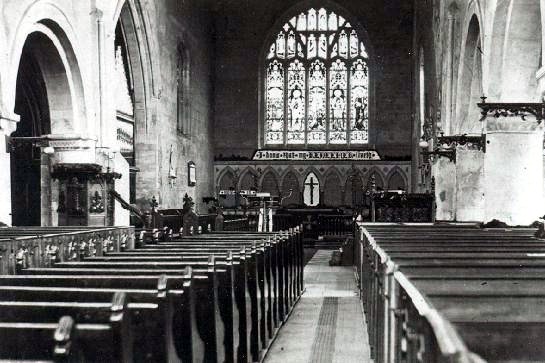 |
|
. . . AND PRESENT |
|
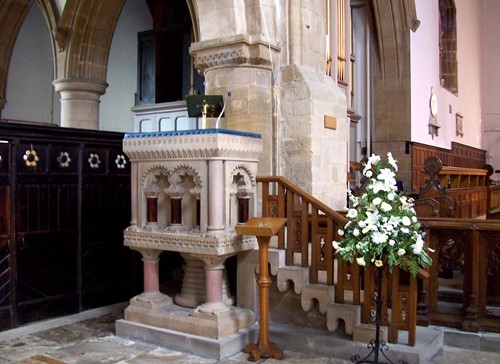 |
|
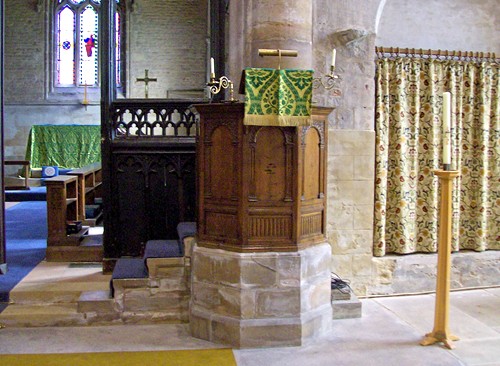
Frampton parish church |
|
POSTSCRIPT |
|
The sale of the pulpit arranged by Robert Mason
Mills in 1890 may not have been such a bad decision after all. My
research has since revealed that the old Jacobean pulpit had been
either badly damaged or even destroyed in a fire a few years before
and so the one which was sold had either been heavily restored or
even completely rebuilt. The outbreak was reported in some detail by the Grantham Journal
on Saturday
21st January 1882:
FIRE: About four o'clock on Saturday afternoon
last, great consternation was caused in the town by a report that
the Abbey Church was on fire, which report to a certain extent was
correct. It would appear that about the time named, Mr Thomas Barsby, baker, was passing the
church and noticed some smoke issuing out of the "stookery"
[stove area]. He
immediately opened the door and was met by a body of fierce flames. He
then went to Dr Tom Harker's residence [at Brook Lodge] and obtained some
buckets and assistance, and ultimately the fire was put out. The river
running close by was a great assistance, there being plenty of water. The
fire engine and firemen were called out but luckily the fire was
extinguished without their assistance but not before steam had been got
up. The property consumed consisted of the old pulpit, some coconut
matting and other sundry material, their value being about £15, which is
covered by insurance in the Phoenix Insurance Office. The cause of the
fire is unknown but it is believed that it originated from the flue of the
heating apparatus. |
REVISED APRIL 2013
Return to The Abbey Church

Go to:
Main Index Villages
Index
|





